11.6 USING ALGEBRAIC PROPERTIES TO REDUCE THE REGISTER REQUIREMENT
11.5 USING DAG FOR CODE GENERATION
To rearrange the final computation order for more-efficient code-generation, we first obtain a DAG representation of the basic block, and then we order the nodes of the DAG using heuristics. Heuristics attempts to order the nodes of a DAG so that, if possible, a node immediately follows the evaluation of its left-most operand.
11.5.1 Heuristic DAG Ordering
The algorithm for heuristic ordering is given below. It lists the nodes of a DAG such that the node's reverse listing results in the computation order.
{ While there exists an unlisted interior node do { select an unlisted node n whose parents have been listed list n while there exists a left-most child m of n that has no unlisted parents and m is not a leaf do { list m m = n } } order = reverse of the order of listing of nodes } | |
Consider the DAG shown in Figure 11.1.
| |

Figure 11.1: DAG Representation.
The order in which the nodes are listed by the heuristic ordering is shown in Figure 11.2.

Figure 11.2: DAG Representation with heuristic ordering.
Therefore, the computation order is:

If the DAG representation turns out to be a tree, then for the machine model described above, we can obtain the optimal order using the algorithm described in Section 11.5.2, below. Here, an optimal order means the order that yields the shortest instruction sequence.
11.5.2 The Labeling Algorithm
This algorithm works on the tree representation of a sequence of three-address statements. It could also be made to work if the intermediate code form was a parse tree. This algorithm has two parts : the first part labels each node of the tree from the bottom up, with an integer that denotes the minimum number of registers required to evaluate the tree and with no storing of intermediate results. The second part of the algorithm is a tree traversal that travels the tree in an order governed by the computed labels in the first part, and which generates the code during the tree traversal.
{ if n is a leaf node then if n is the left-most child of its parent then label( n ) = 1 else label( n ) = 0 else label( n ) = max[label( n i ) + ( i - 1)] for i = 1 to k /* where n 1 , n 2 ,..., n k are the children of n , ordered by their labels; that is, label( n 1 ) label( n 2 ) ... label( n k ) */ } For k = 2, the formula label( n ) = max[label( n i ) + ( i - 1)] becomes: label( n ) = max[11, 12 + 1] where 11 is label( n 1 ), and 12 is label( n 2 ). Since either 11 or 12 will be same, or since there will be a difference of at least the difference between 11 and 12 (i.e., 11 ˆ’ 12), which is greater than or equal to one, we get:
| |
Consider the following three-address code and its DAG representation, shown in Figure 11.3:

| |
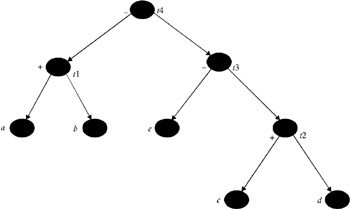
Figure 11.3: DAG representation of three-address code for Example 11.3.
The tree, after labeling, is shown in Figure 11.4.
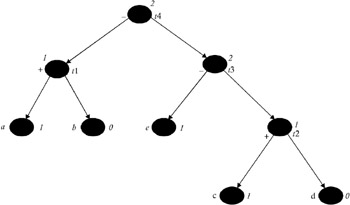
Figure 11.4: DAG representation tree after labeling.
11.5.3 Code Generation by Traversing the Labeled Tree
We will now examine an algorithm that traverses the labeled tree and generates machine code to evaluate the tree in the register R 0. The content of R 0 can then be stored in the appropriate memory location. We assume that only binary operators are used in the tree. The algorithm uses a recursive procedure, gencode( n ), to generate the code for evaluating into a register a subtree that has its root in node n . This procedure makes use of RSTACK to allocate registers.
Initially, RSTACK contains all available registers. We assume the order of the registers to be R 0, R 1, , from top to bottom. A call to gencode() may find a subset of registers, perhaps in a different order in RSTACK, but when gencode() returns, it leaves the registers in RSTACK in the same order in which they were found. The resulting code computes the value of the tree in the top register of RSTACK. It also makes use of TSTACK to allocate temporary memory locations. Depending upon the type of node n with which gencode() is called, gencode() performs the following:
-
If n is a leaf node and is the left-most child of its parent, then gencode() generates a load instruction for loading the top register of RSTACK by the label of node n :

-
If n is an interior node, it will be an operator node labeled by op with the children n 1 and n 2 , and n 2 is a simple operand and not a root of the subtree, as shown in Figure 11.5.
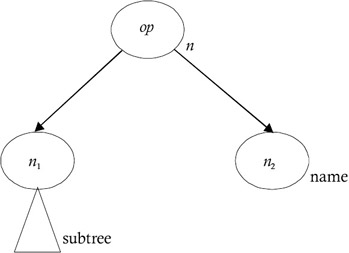
Figure 11.5: The node n is an operand and not a subtree root.In this case, gencode() will first generate the code to evaluate the subtree rooted at n 1 in the top{RSTACK]. It will then generate the instruction, OP name , RSTACK[top].
-
If n is an interior node, it will be an operator node labeled by op with the children n 1 and n 2 , and both n 1 and n 2 are roots of subtrees, as shown in Figure 11.6.
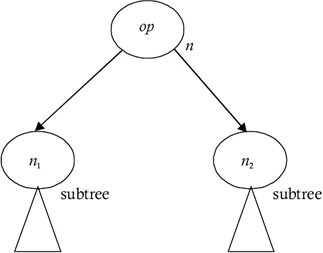
Figure 11.6: The node n is an operator, and n 1 and n 2 are subtree roots.In this case, gencode() examines the labels of n 1 and n 2 . If label( n 2 ) > label( n 1 ), then n 2 requires a greater number of registers to evaluate without storing the intermediate results than n 1 does. Therefore, gencode() checks whether the total number of registers available to r is greater than the label( n 1 ). If it is, then the subtree rooted at n 1 can be evaluated without storing the intermediate results. It first swaps the top two registers of RSTACK, then generates the code for evaluating the subtree rooted at n 2 , which is harder to evaluate in RSTACK[top]. It removes the top-most register from RSTACK and stores it in R , then generates code for evaluating the subtree rooted at n 1 in RSTACK[top]. An instruction, OP R, RSTACK[top], is generated, pushing R onto RSTACK. The top two registers are swapped so that the register holding the value of n will be in the top register of RSTACK.
-
If label( n 2 ) <= label( n 1 ), then n 1 requires a greater number of register to evaluate without storing the intermediate results than n 2 does. Therefore, gencode() checks whether the total number of registers available to r is greater than label( n 2 ). If it is, then the subtree rooted at n 2 can be evaluated without storing the intermediate results. Hence, it first generates the code for evaluating subtree rooted at n 1 , which is harder to evaluate in RSTACK[top], removes the top-most register from RSTACK, and stores it in R . It then generates code for evaluating the subtree rooted at n 2 in RSTACK[top]. An instruction, OP RSTACK[top], R, is generated that pushes register R onto RSTACK. In this case, the top register, after pushing R onto RSTACK, holds the value of n . Therefore, swapping and reswapping is needed.
-
If label( n 1 ) as well as label( n 2 ) are greater than or equal to r (i.e., both subtrees require r or more registers to evaluate without intermediate storage), a temporary memory location is required. In this case, gencode() first generates the code for evaluating n 2 in a temporary memory location, then generates code to evaluate n 1 , followed by an instruction to evaluate root n in the top register of RSTACK.
Algorithm for Implementing Gencode()
The procedure for gencode() is outlined as follows:
Procedure gencode(n)
{ if n is a leaf node and the left-most child of its parent then generate MOV name, RSTACK[top] if n is an interior node with children n 1 and n 2 , with label( n 2 ) = 0 then { gencode( n 1 ) generate op name RSTACK[top] /* name is the operand represented by n 2 and op is the operator represented by n */ } if n is an interior node with children n 1 and n 2 ,
label( n 2 ) > label( n 1 ), and label( n 1 ) < r then { swap top two registers of RSTACK gencode( n 2 ) R = pop(RSTACK) gencode( n 1 ) generate op R , RSTACK[top] /* op is the operator represented by n */ PUSH( R ,RSTACK) swap top two registers of RSTACK } if n is an interior node with children n 1 and n 2 ,
label( n 2 ) <= label( n 1 ), and label( n 2 ) < r then { gencode( n 1 ) R = pop(RSTACK) gencode( n 2 ) generate op RSTACK[top], R /* op is the operator represented by n */ PUSH( R , RSTACK) } if n is an interior node with children n 1 and n 2 ,
label( n 2 ) <= label( n 1 ), and label( n 1 ) > r as well as label( n 2 ) > r then { gencode( n 2 ) T = pop(TSTACK) generate MOV RSTACK[top], T gencode( n 1) PUSH( T , TSTACK) generate op T , RSTACK[top] /* op is the operator represented by n */ } } The algorithm above can be used when the DAG represented is a tree; but when there are common subexpressions in the basic block, the DAG representation will no longer be a tree, because the common subexpressions will correspond to nodes with more than one parent. These are called "shared nodes". In this case, we can apply the labeling and the gencode() algorithm by partitioning the DAG into a set of trees. We find, for each shared node as well as root n , the maximal subtree with n as a root that includes no other shared nodes, except as leaves. For example, consider the DAG shown in Figure 11.7. It is not a tree, but it can be partitioned into the set of trees shown in Figure 11.8. The procedure gencode() can be used to generate code for each node of this tree.
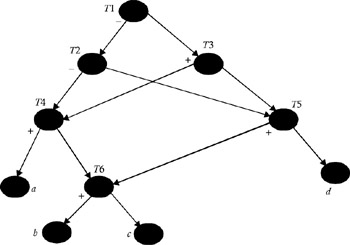
Figure 11.7: A nontree DAG.
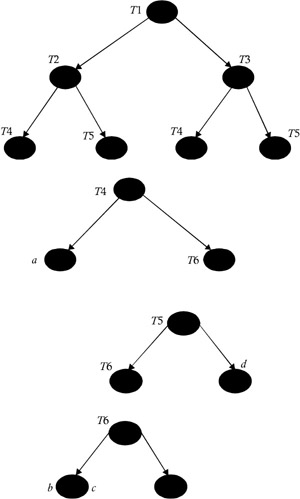
Figure 11.8: A DAG that has been partitioned into a set of trees.
| |
Consider the labeled tree shown in Figure 11.9.
| |
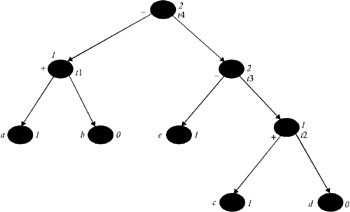
Figure 11.9: Labeled tree for Example 11.4.
The code generated by gencode() when this tree is given as input along with the recursive calls of gencode is shown in Table 11.7. It starts with call to gencode() of t 4. Initially, the top two registers will be R 0 and R 1.
| Call to Gencode() | Action Taken | RSTACK Contents Top Two Registers | Code Generated |
|---|---|---|---|
| R 0, R 1 | |||
| gencode( t 4) | Swap top two registers Call gencode( t 3) Pop R 1 Call gencode( t 1) Generate an instruction SUB R1,R0 Push R 1 Swap top two registers | R 1, R | MOV E, R1 |
| gencode( t 3) | Call gencode( E ) Pop R 1 Call gencode( t 2) Generate an instruction SUB R0,R1 Push R 1 | R 1, R | MOV E, R1 |
| gencode( E ) | Generate an instruction MOV E, R1 | R 1, R | MOV E, R1 |
| gencode( t 2) | gencode( c ) Generate an instruction ADD D, R0 | R | MOV C, R0 |
| gencode( c ) | Generate an instruction MOV C, R0 | R | |
| gencode( t 1) | gencode( A ) Generate an instruction ADD B, R0 | R | MOV A, R0 |
| gencode( A ) | Generate an instruction MOV A, R0 | R | MOV A, R0 |
EAN: 2147483647
Pages: 108
- Key #1: Delight Your Customers with Speed and Quality
- Key #3: Work Together for Maximum Gain
- Beyond the Basics: The Five Laws of Lean Six Sigma
- Making Improvements That Last: An Illustrated Guide to DMAIC and the Lean Six Sigma Toolkit
- The Experience of Making Improvements: What Its Like to Work on Lean Six Sigma Projects